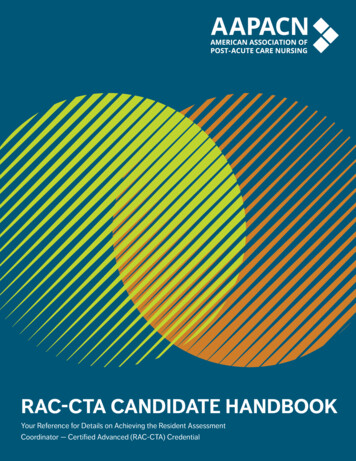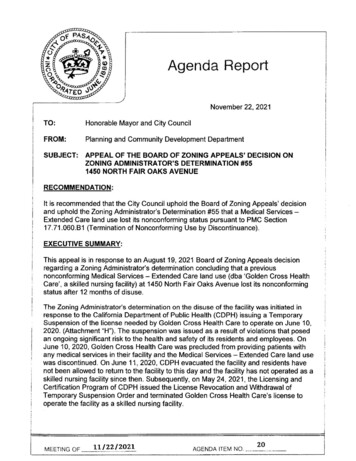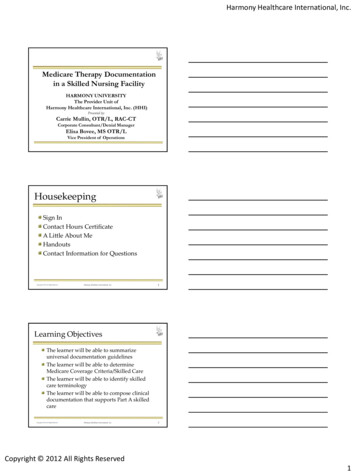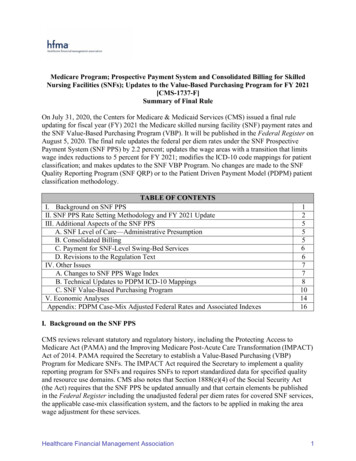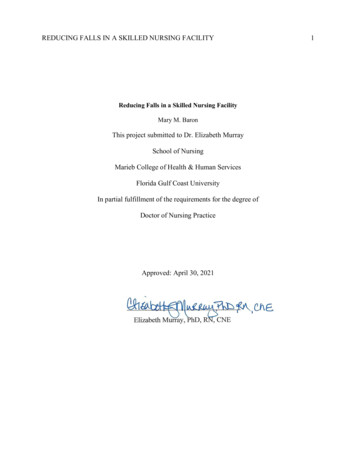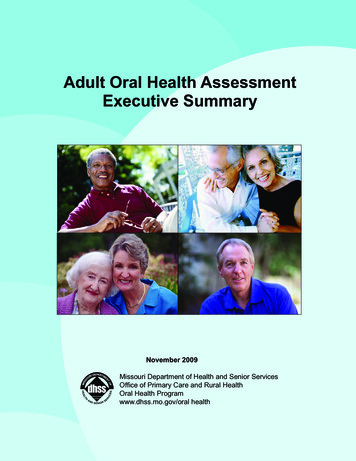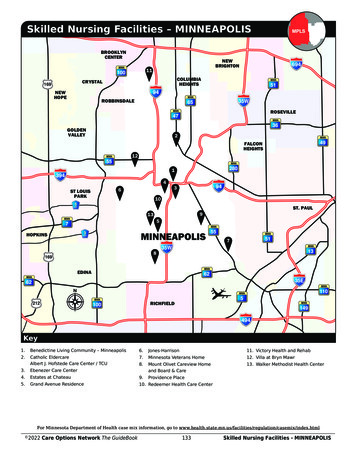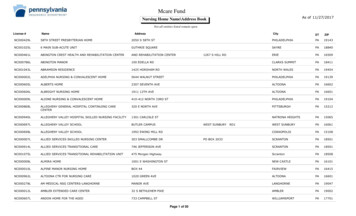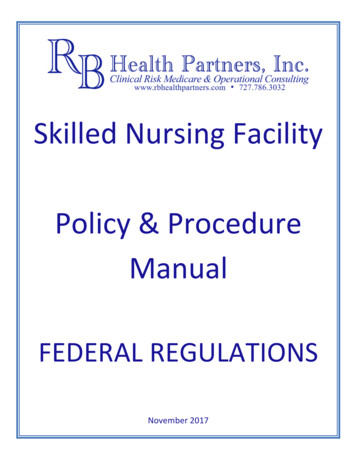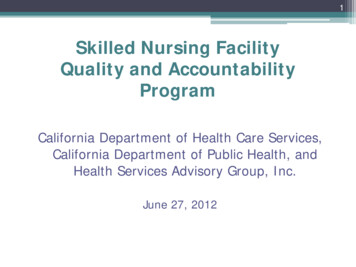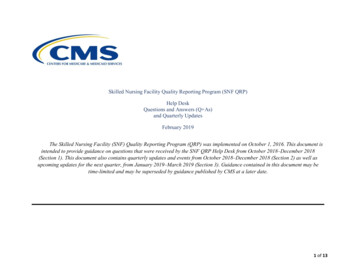
Transcription
Skilled Nursing Facility Value-BasedPurchasing (SNF VBP) ProgramPerformance Score Report User GuideFiscal Year 2022
SNF VBP Program Performance Score Report User GuideContentsAcronyms . iiiI.II.Overview .1A.Confidential feedback reports .1B.Review and Correction process.2Background .3A.FY 2022 updates .3B.Incentive payment calculation methodology .4C. Public reporting .7III. PSR File Contents and Descriptions .8A.Cover Sheet .8B.Facility Performance .8C. Payment Information .9D. Data Dictionary .9IV. Contacts and Additional Resources .10TablesTable 1. SNF VBP Program data periods: FY 2020 through 2024 . 1Table 2. FY 2022 SNF VBP Program performance standards. 5Table 3. Your SNF’s performance results (Worksheet 2—Facility Performance contents) . 8Table 4. Interpreting IPMs (Worksheet 3—Payment Information contents) . 9ii
SNF VBP Program Performance Score Report User GuideAcronymsCASPERCertification and Survey Provider Enhanced ReportsCCNCMS Certification NumberCMSCenters for Medicare & Medicaid ServicesFFSfee-for-serviceFYfiscal yearHIPAAHealth Insurance Portability and Accountability Act of 1996IPMincentive payment multiplierLVAlow-volume adjustmentNQFNational Quality ForumPAMAProtecting Access to Medicare Act of 2014PDCProvider Data CatalogPHIprotected health informationPIIpersonally identifiable informationPPSprospective payment systemPSRPerformance Score ReportQIESQuality Improvement and Evaluation SystemR&CReview and CorrectionRSRRrisk-standardized readmission rateSNF VBPSkilled Nursing Facility Value-Based PurchasingSNFRMSkilled Nursing Facility 30-Day All-Cause Readmission Measureiii
SNF VBP Program Performance Score Report User GuideI. OverviewThis user guide accompanies the Performance Score Report (PSR) for the fiscal year (FY) 2022 SkilledNursing Facility Value-Based Purchasing (SNF VBP) Program year. The PSR is available to download inMicrosoft Excel format from the Internet Quality Improvement and Evaluation System(iQIES)/Certification and Survey Provider Enhanced Reports (CASPER) reporting system.The PSR contains your SNF’s performance results for the FY 2022 SNF VBP Program year, which aresubject to the suppression policy adopted in the FY 2022 SNF PPS final rule. (For more information onthe suppression policy implemented for the FY 2022 SNF VBP Program year, see Section II.A of thisuser guide.) The results include the incentive payment multiplier (IPM) that the Centers for Medicare &Medicaid Services (CMS) will apply to your SNF’s Medicare fee-for-service (FFS) Part A claims in FY2022, from October 1, 2021 through September 30, 2022.CMS assesses SNFs’ performance on the SNF 30-Day All-Cause Readmission Measure (SNFRM) duringa baseline period and a performance period. Table 1 shows these two periods for the FY 2020 through2024 Program years, as finalized through rulemaking.Table 1. SNF VBP Program data periods: FY 2020 through 2024SNF VBP Program yearBaseline periodPerformance periodFY 2020FY 2016 (10/1/2015–9/30/2016)FY 2018 (10/1/2017–9/30/2018)FY 2021FY 2017 (10/1/2016–9/30/2017)FY 2019 (10/1/2018–9/30/2019)FY 2022FY 2018 (10/1/2017–9/30/2018)4/1/2019–12/1/2019aFY 2023FY 2019 (10/1/2018–9/30/2019)FY 2021 (10/1/2020–9/30/2021)FY 2024FY 2019 (10/1/2018–9/30/2019)FY 2022 (10/1/2021–9/30/2022)In response to the COVID-19 public health emergency, CMS is excluding qualifying claims in the first two quartersof Calendar Year (CY) 2020 (January 1, 2020 – June 30, 2020) from use in the SNF VBP Program. Additionally,because the SNFRM assesses hospital readmissions within 30 days of discharge from a prior hospitalization to aSNF and requires data from 12 months prior to the start of the SNF stay for risk adjustment, residents that weredischarged from the hospital to the SNF after December 1, 2019 and residents with SNF admissions from July 1,2020 – September 30, 2020 are excluded from the SNFRM calculations due to missing data. Thus, the FY 2022 SNFVBP Program performance period originally specified in the interim final rule with comment period has been restrictedto April 1, 2019 through December 1, 2019. For further information please see pages 54835 through 54837 of theinterim final rule with comment period and the FY 2022 SNF PPS final rule.aFY fiscal year; SNF VBP Skilled Nursing Facility Value-Based Purchasing.A. Confidential feedback reportsThe following confidential feedback reports contain your SNF’s stay-level results for the FY 2022Program year: A full-year workbook containing baseline period data, distributed in December 2020 An interim workbook containing partial performance period data, distributed in March 2021 A full-year workbook containing performance period data, distributed in June 20211
SNF VBP Program Performance Score Report User GuideThis user guide describes the data in each worksheet of the final confidential feedback report, the PSR,and provides reference information and instructions for interpreting the PSR. The guide consists of foursections:1. Overview2. Background3. PSR File Contents and Descriptions4. Contacts and Additional ResourcesPSRs are read-only documents, which prevents users from unintentionally altering content. To edityour SNF’s PSR, use the File Save As option to save the document with a different file name.B. Review and Correction processCMS grants SNFs a 30-day Review and Correction (R&C) period to review the results in their PSRbefore these data are made publicly available. This is Phase 2 of the R&C process, during which SNFsmay review and submit corrections to only their performance score contained in their PSR. Afterdissemination of the PSR, correction requests are accepted for up to 30 calendar days.During Phase 1 of the R&C process, SNFs had the opportunity to review and submit corrections to thequality measure information contained in their quality measure quarterly reports for the baseline period(distributed in December 2020) and performance period (distributed in June 2021). Similar to Phase 2R&C, correction requests were accepted for up to 30 calendar days after dissemination of theapplicable report. CMS used the information from these two reports to calculate the results containedin the PSRs.SNFs must submit correction requests to the SNF VBP Program Help Desk at SNFVBP@rti.org within30 calendar days after dissemination of the PSR. Requests must include the following information: The SNF’s CMS Certification Number (CCN) The SNF’s name The correction requested The reason for requesting the correctionDo NOT submit protected health information (PHI) or patient identifiable information (PII) to theSNF VBP Program Help Desk. Any disclosure of PHI should only be in accordance with, and to theextent permitted by, the Health Insurance Portability and Accountability Act of 1996 (HIPAA) andother applicable laws.2
SNF VBP Program Performance Score Report User GuideII. BackgroundThrough the SNF VBP Program, CMS awards incentive payments to SNFs for the quality of care theyprovide to Medicare beneficiaries, as measured by SNFs’ performance on a single hospital readmissionsmeasure. Section 215 of the Protecting Access to Medicare Act of 2014 (PAMA) added sections 1888(g)and (h) to the Social Security Act, which required the Secretary to establish a SNF VBP Program. PAMAspecifies that under the SNF VBP Program, SNFs: Are evaluated by their performance on a hospital readmission measure Are scored on both improvement and achievement Receive quarterly confidential feedback reports containing information about their performance Earn incentive payments based on their performanceCMS began awarding incentive payments to SNFs on October 1, 2018. These incentive payments areapplied prospectively to all Medicare FFS Part A claims paid under the SNF Prospective Payment System(PPS).All SNFs paid under Medicare’s SNF PPS are included in the SNF VBP Program. SNFs’ performance inthe Program is currently based on their results on the SNFRM, a quality measure endorsed by theNational Quality Forum (NQF #2510).Section 111 of the Consolidated Appropriations Act of 2021 amended Section 1888(h) of the SocialSecurity Act to allow the Secretary to apply additional measures determined appropriate by the Secretaryto the SNF VBP Program for payments for services furnished on or after October 1, 2023.A. FY 2022 updatesIn the FY 2022 Program year, CMS updated the baseline and performance periods for assessing SNFperformance on the SNFRM. As finalized through rulemaking, the FY 2022 Program year’s baselineperiod is FY 2018 (October 1, 2017, to September 30, 2018) and the performance period is April 1, 2019,to December 1, 2019 1.CMS suppressed the use of SNF readmission measure data for purposes of FY 2022 scoring and paymentadjustments in the FY 2022 SNF VBP Program year because the effects of the COVID-19 public healthemergency on the data used to calculate the SNFRM inhibited CMS’s ability to make fair nationalcomparisons of SNFs’ performance. Under the suppression policy, CMS calculated an RSRR for both thebaseline and performance period and then suppressed the use of SNF readmission measure data forpurposes of scoring. CMS instead assigned each SNF a performance score of 0.00000 to mitigate theeffect that the COVID-19 public health emergency would otherwise have had on SNFs’ performancescores and incentive payment multipliers. The suppression policy was adopted in the FY 2022 SNF PPSIn response to the COVID-19 public health emergency, CMS is excluding qualifying claims in the first twoquarters of Calendar Year (CY) 2020 (January 1, 2020 – June 30, 2020) from use in the SNF VBP Program.Additionally, because the SNFRM assesses hospital readmissions within 30 days of discharge from a priorhospitalization to a SNF and requires data from 12 months prior to the start of the SNF stay for risk adjustment,residents that were discharged from the hospital to the SNF after December 1, 2019 and residents with SNFadmissions from July 1, 2020 – September 30, 2020 are excluded from the SNFRM calculations due to missing data.Thus, the FY 2022 SNF VBP performance period originally specified in the interim final rule with comment periodhas been restricted to April 1, 2019 through December 1, 2019. For further information please see pages 54835through 54837 of the interim final rule with comment period and the FY 2022 SNF PPS final rule.13
SNF VBP Program Performance Score Report User Guidefinal rule. Per this policy, each SNF received an identical incentive payment multiplier, and SNFs did notreceive an achievement score, improvement score, or rank. CMS then applied the low-volume adjustmentpolicy as previously finalized on pages 39278–39280 of the FY 2019 SNF PPS final rule; SNFs subject tothe low-volume adjustment policy were assigned a net-neutral incentive payment multiplier. Referenceinformation and instructions for interpreting the PSR in light of this suppression policy are includedbelow in Section III.B. Incentive payment calculation methodologyFor each SNF, CMS determines incentive payments by calculating each SNF’s IPM. CMS applies thismultiplier to a SNF’s adjusted federal per diem rate whenever payments are made for the SNF’s MedicareFFS Part A claims.CMS used nine main steps to calculate each SNF’s IPM for the FY 2022 Program year. Only Step 3below was modified due to the suppression policy adopted in the FY 2022 SNF PPS final rule ascompared to a standard Program year.1. Calculate risk-standardized readmission rates (RSRRs). The SNF VBP Program tracks eachSNF’s performance on the SNFRM during a baseline period and performance period. CMS calculatedan RSRR for both the baseline period and performance period using the following equation:The predicted number of readmissions is the number of unplanned readmissions predicted based on aSNF’s performance given their unique case mix. The expected number of readmissions is the numberof unplanned readmissions that would be expected if the residents at a given SNF were treated at theaverage SNF.CMS previously provided SNFs their baseline period RSRR in the quality measure quarterly reportfor the baseline period, distributed in December 2020. Likewise, CMS provided SNFs theirperformance period RSRR in the quality measure quarterly report for the performance period,distributed in June 2021. 2 CMS inverts the RSRRs for the baseline and performance periods bysubtracting the RSRR from 1:2. Calculate the achievement threshold and benchmark. CMS calculated two performance standardsfor the SNF VBP Program: the achievement threshold and the benchmark. The achievement thresholdis the 25th percentile of all SNFs’ performance on the SNFRM during the baseline period. Thebenchmark is the mean of the top decile of all SNFs’ performance on the SNFRM during the baselineperiod.Both the baseline period and performance period RSRRs are subject to Phase 1 of the R&C Process. If a SNFsubmits a successful correction request during Phase 1 of the R&C Process, the affected RSRR results in the SNF’sPSR could differ from the results previously provided in the quality measure quarterly reports for the baseline and/orperformance period.24
SNF VBP Program Performance Score Report User GuideCMS publishes the SNF VBP Program performance standards in the SNF PPS final rule before theapplicable Program year’s performance period begins. Table 2 shows the performance standards forthe FY 2022 Program year.Table 2. FY 2022 SNF VBP Program performance standardsSNF VBP Program yearFY 2022Achievement thresholdBenchmark0.790590.82905SNF PPS final ruleFY 2020 SNF PPS final rule(page 38822)aCMS initially published the performance standards for the FY 2022 Program year in the FY 2020 SNF PPS final ruleand later updated the performance standards in April 2021 via a CASPER email announcement sent to all SNFs.a3. Determine the performance scores for all SNFs. Per the suppression policy finalized in the FY2022 SNF PPS final rule, CMS assigned each SNF a performance score of 0.00000. 3 Under thispolicy: CMS suppressed the use of SNF readmission measure data for purposes of FY 2022 SNF VBPProgram scoring and payment adjustments because the effects of the COVID-19 public healthemergency on the data used to calculate the SNFRM inhibited CMS’s ability to make fairnational comparisons of SNFs’ performance. CMS calculated an RSRR for both the baseline and performance period and then suppressed theuse of SNF readmission measure data for purposes of scoring. CMS assigned each SNF aperformance score of zero to mitigate the effect that the COVID-19 public health emergencywould otherwise have had on SNFs’ performance scores and incentive payment multipliers.CMS finalized the suppression policy in the FY 2022 SNF PPS final rule.For more information on how incentive payment multipliers are determined in the FY 2022 Program year,see the SNF VBP Program: FY 2022 Incentive Payment Multiplier Calculation Infographic.4. Transform performance scores for all SNFs. CMS transformed performance scores for all SNFs(which range from 0 to 100, rounded 5 decimal places) using the logistic exchange function below, sovalues now range from 0 to 1. Due to the suppression policy adopted in the FY 2022 SNF PPS finalrule, all SNFs have an identical transformed performance score.5. Calculate the incentive payment pool for all SNFs. CMS calculated the incentive payment pool forall SNFs as 60 percent of 2 percent of SNFs’ Medicare FFS Part A payments.CMS finalized a 60 percent payback percentage as part of the FY 2018 SNF PPS final rule, see pages36619 through 36621, and discussed maintaining the 60 percent payback percentage for the FY 2022SNF VBP Program year in the FY 2022 SNF PPS final rule.3To see how performance scores are calculated in a standard Program year, in absence of a suppression policy, seeStep 3 of the SNF VBP FY 2021 Incentive Payment Multiplier Calculation Infographic.5
SNF VBP Program Performance Score Report User Guide6. Calculate a scaling factor. CMS calculated a scaling factor to ensure that the sum of all SNFs’incentive payment adjustments equals the incentive payment pool using the equation below:7. Determine each SNF’s incentive payment adjustment. CMS calculated each SNF’s incentivepayment adjustment using the equation below:8. Calculate each SNF’s IPM. CMS calculated each SNF’s IPM, which simultaneously accounts forthe 2 percent withhold and the incentive payment adjustment, as shown in the equation below:CMS applies each SNF’s IPM to the adjusted federal per diem rate. When payments are made for aSNF’s Medicare FFS Part A claims, CMS multiplies the adjusted federal per diem rate by the IPM.9. Apply the low-volume adjustment (LVA). CMS implemented the LVA policy starting with the FY2020 SNF VBP Program year. The following is a summary of this policy: SNFs with fewer than 25 stays in the performance period of a given Program year, regardless ofthe number of stays in the baseline period, will automatically receive a net-neutral incentivepayment multiplier of 1.0 for that Program year. This means that the Program will not affect theirpayment. These SNFs will also receive a neutral performance score and rank. In a standard Program year, SNFs with 25 stays or more in the performance period of a givenProgram year and fewer than 25 stays in the baseline period will be scored on achievement only.CMS will not score these SNFs on improvement. The achievement score will equal theperformance score. However, these SNFs are subject to the suppression policy discussed in Step 3above and were assigned a performance score of zero.CMS finalized the LVA policy on pages 39278 through 39280 of the FY 2019 SNF PPS final ruleand discussed maintaining the LVA policy for the FY 2022 Program year in the FY 2022 SNF PPSfinal rule.See the SNF VBP Program Exchange Function Methodology Report for more information about why thelogistic exchange function was selected and how SNF performance scores are used to derive incentivepayments.See the SNF VBP Program: FY 2021 Incentive Payment Multiplier Calculation Infographic for moreinformation and examples of how CMS calculates performance standards, performance scores, and IPMsin a standard Program year, in absence of a suppression policy.6
SNF VBP Program Performance Score Report User GuideC. Public reportingCMS publicly reports SNF VBP Program facility-level and aggregate-level results on the Provider DataCatalog (PDC) website. Generally, CMS makes these results publicly available in the fall followingdistribution of the annual PSRs, which are typically distributed in August.The publicly reported facility-level results include the following: SNF VBP Program rankings Facility information (CCNs, facility names, and facility addresses) Baseline period RSRRs Performance period RSRRs Achievement scores Improvement scores Performance scores IPMsThe publicly reported aggregate-level results include the following: The national average RSRRs for the baseline period and performance period The achievement threshold and benchmark The range of performance scores The total number of SNFs receiving value-based incentive payments The range of IPMs The range of value-based incentive payments (in dollars) The total amount of value-based incentive payments (in dollars)Because the effects of the COVID-19 public health emergency on the data used to calculate the SNFRMinhibited CMS’s ability to make fair national comparisons of SNFs’ performance, CMS finalized ameasure suppression policy in the FY 2022 SNF PPS final rule. Per this suppression policy, CMScalculated an RSRR for both the baseline and performance period and then suppressed the use of SNFreadmission measure data for purposes of scoring. As a result, only the baseline period RSRR,performance period RSRR, performance score, and IPM will be publicly reported for the FY 2022Program year, all bolded above; Program ranks, achievement scores, and improvement scores will not bepublicly reported.Additionally, starting with data for the FY 2020 SNF VBP Program year, as part of the LVA policy SNFswith fewer than 25 eligible stays during the baseline period will not have their baseline period RSRR orimprovement score publicly reported. SNFs with fewer than 25 eligible stays during the performanceperiod will not have their performance period RSRR, achievement score, or improvement score publiclyreported. For more information on this policy, see page 38824 of the FY 2020 SNF PPS final rule.7
SNF VBP Program Performance Score Report User GuideIII. PSR File Contents and DescriptionsThis section describes the information in your SNF’s PSR. The PSR contains your SNF’s performanceresults for the FY 2022 SNF VBP Program year. This includes the IPM that CMS will apply to yourSNF’s Medicare FFS Part A claims in FY 2022 (October 1, 2021, through September 30, 2022).The PSR contains four worksheets:1. Cover Sheet2. Facility Performance3. Payment Information4. Data DictionaryA. Cover SheetThe first worksheet describes the contents of the PSR, introduces the SNF VBP Program, and includescontact information and links to additional resources.B. Facility PerformanceThe second worksheet (Facility Performance) in the PSR provides your SNF’s performance results for theFY 2022 SNF VBP Program year. Table 3 describes the variables presented in the Facility Performanceworksheet.Table 3. Your SNF’s performance results (Worksheet 2—Facility Performance contents)Column nameDescriptionBaseline Period RSRRYour SNF’s rate of unplanned readmissions during the baseline period (FY 2018).This rate is adjusted for stay-level risk factors such as clinical characteristics andcomorbidities, as calculated by the SNFRM (NQF #2510). SNFs with fewer than 25eligible stays during the baseline period will not receive a baseline period RSRR, andtheir PSR will contain a triple dash: “---.” Provided no corrections were made as aresult of R&C Phase 1, this value will match the baseline period RSRR included inyour SNF’s quality measure quarterly report for the baseline period, previouslydistributed in December 2020.Performance Period RSRRYour SNF’s rate of unplanned readmissions during the performance period(4/1/2019–12/1/2019). This rate is adjusted for stay-level risk factors such as clinicalcharacteristics and comorbidities, as calculated by the SNFRM (NQF #2510). SNFswith fewer than 25 eligible stays during the performance period will not receive aperformance period RSRR, and their PSR will contain a triple dash: “---.” Provided nocorrections were made as a result of R&C Phase 1, this value will match theperformance period RSRR included in your SNF’s quality measure quarterly reportfor the performance period, previously distributed in June 2021.Achievement ScoreA measure of how well each SNF performed during the performance periodcompared with national SNF performance during the baseline period. Scores rangefrom 0 to 100, with higher scores indicating better performance. However, per theFY 2022 Program year suppression policy, all SNFs will not receive anachievement score, and their PSR will contain a triple dash: “---.” For a fullexplanation of how SNF achievement scores are calculated, see Step 3 of theincentive payment calculation methodology in this user guide.8
SNF VBP Program Performance Score Report User GuideColumn nameDescriptionImprovement ScoreA measure of how much a SNF improved from the baseline period to theperformance period. Scores range from 0 to 90, with higher scores indicating betterperformance. However, per the FY 2022 Program year suppression policy, allSNFs will not receive an improvement score, and their PSR will contain a tripledash: “---.” For a full explanation of how SNF improvement scores are calculated,see Step 3 of the incentive payment calculation methodology in this user guide.Performance ScoreThe higher of a SNF’s achievement score and improvement score. Scores rangefrom 0 to 100, with higher scores indicating better performance. However, per theFY 2022 Program year suppression policy, all SNFs will receive 0.00000 as theirperformance score. CMS uses this score to calculate incentive paymentmultipliers for the SNF VBP Program. SNFs with fewer than 25 eligible staysduring the performance period will receive a net-neutral performance score.Program RankA SNF’s national rank in the SNF VBP Program. However, per the FY 2022Program year suppression policy, all SNFs will not be ranked, and their PSRwill contain a triple dash: “---.”Incentive Payment Multiplier A multiplier assigned to a SNF based on its performance in the SNF VBP Program.When payments are made for a SNF’s Medicare FFS Part A claims, CMS multipliesthe adjusted federal per diem rate by this multiplier. However, per the FY 2022Program year suppression policy, all SNFs will receive an incentive paymentmultiplier of 0.992. SNFs with fewer than 25 eligible stays during the performanceperiod will receive a net-neutral incentive payment multiplier of 1.0.C. Payment InformationThe third worksheet (Payment Information) in the PSR provides your SNF’s payment information for theFY 2022 SNF VBP Program year. The worksheet includes your IPM for FY 2022 (the same IPM foundon the Facility Performance worksheet) and describes how to interpret it. Table 4 describes how tointerpret the IPMs in the Payment Information worksheet.Table 4. Interpreting IPMs (Worksheet 3—Payment Information contents)Incentive payment multiplier resultInterpretationIncentive payment multiplier 1Your SNF’s incentive payment multiplier is net negative, meaning yourSNF will receive less than the 2 percent withhold back. That is, yourSNF will earn back less than it would have in the absence of the SNFVBP Program.Incentive payment multiplier 1Your SNF’s incentive payment multiplier is net neutral, meaning yourSNF will receive the 2 percent withhold back. That is, your SNF willearn back the same amount it would have in the absence of the SNFVBP Program.Incentive payment multiplier 1Your SNF’s incentive payment multiplier is net positive, meaning yourSNF will receive more than the 2 percent withhold back. That is, yourSNF will earn back more than it would have in the absence of the SNFVBP Program.D. Data DictionaryThe final worksheet in the PSR is the data dictionary. This worksheet includes the variable names anddescriptions of the data found in Worksheet 2—Facility Performance and Worksheet 3—PaymentInformation.9
SNF VBP Program Performance Score Report User GuideIV. Contacts and Additional ResourcesMore information on the SNF VBP Program, including the Program’s scoring methodology, confidentialfeedback reports, public reporting efforts, and R&C process, is available on the SNF VBP Programwebpage on CMS.gov.Submit questions about the SNF VBP Program via email to the SNF VBP Program Help Desk atSNFVBP@rti.org.10
period is FY 2018 (October 1, 2017, to September 30, 2018) and the performance period is April 1, 2019, to December 1, 2019. . Thus, the FY 2022 SNF VBP performance period originally specified in the interim final rule with comment period has been restricted to April 1, 2019 through December 1, 2019. For further information please see pages 54835
